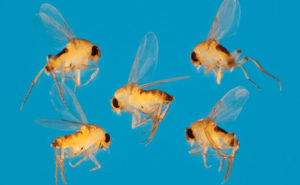
These phorid flies have nine new branches to their family tree, thanks to the quarantine. Photo courtesy of, and copyrighted by, Gene White, pmimages@earthlink.net
Social distancing at home means we all have a lot more time on our hands. But instead of starting a sourdough bread recipe or finally getting around to finishing that crochet afghan begun in 1998 (two things I have talked about doing, but have yet to do), I learned that two Los Angles, Calif.-based entomologists have been putting their open schedules to good use.
According to Wired.com, Lisa Gonzalez, assistant entomology collection manager for the Natural History Museum of Los Angeles, and Brian Brown, the museum’s curator of entomology, have discovered nine new phorid fly species as they worked their way through a collection in their respective home laboratories.
Gonzalez temporarily converted her craft room for the cause; news reports do not say whether Brown had an existing home lab pre COVID-19.
Per Wired:
The insects, mostly small flies, wasps, and wasplike flies, had been collected through the BioSCAN project, which began in 2012 with insect traps set at 30 sites throughout Los Angeles, mostly in backyards or public spaces. The pair recruited volunteers who were then trained in how to use the “Malaise traps,” which resemble two-person pup tents that force bugs to fly upward into collecting nets before the volunteers can put them into vials.
Normally, Gonzalez and other biologists would use DNA bar-coding to identify different species. It’s a multistep process that takes a few hours of chemical preparation and gives spot-on results. The museum’s DNA sequencer uses a method called polymerase chain reaction to amplify the genetic material from each insect, which then can be compared to a reference of existing DNA barcodes.
With that device back at the museum, Gonzalez switched to the analog instrument that has served biologists since the 17th century: a microscope.
It’s painstaking work, but ultimately rewarding, both Gonzalez and Brown told Wired. And it confirms a conceit of which pest management professionals are already well aware: There’s still a lot about insect biology and behavior left to learn.
Leave A Comment